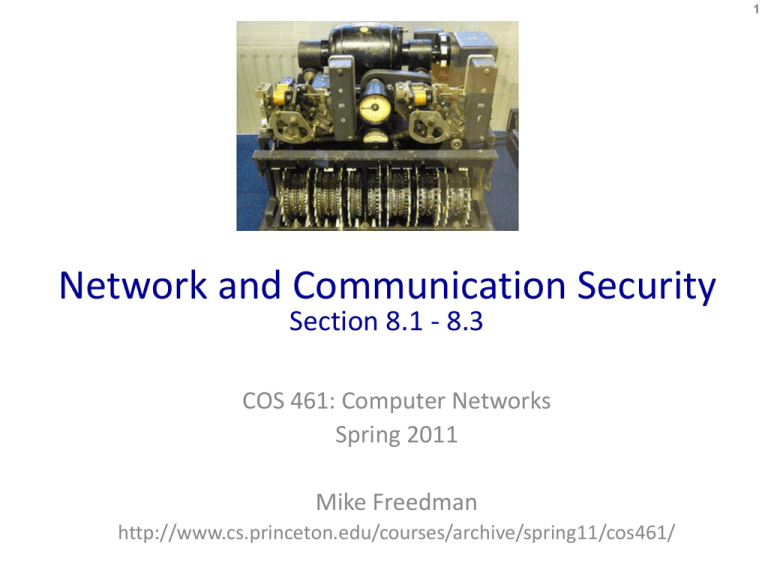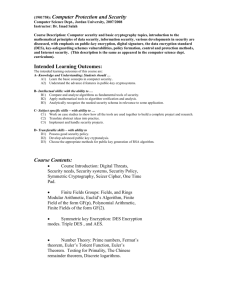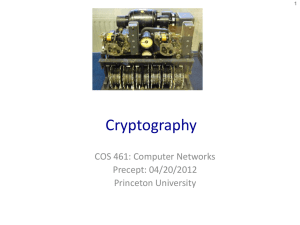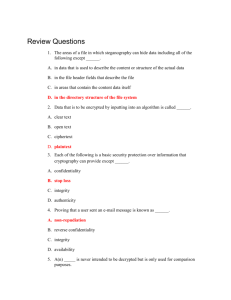Network and Communication Security Section 8.1 - 8.3 COS 461: Computer Networks
advertisement

1
Network and Communication Security
Section 8.1 - 8.3
COS 461: Computer Networks
Spring 2011
Mike Freedman
http://www.cs.princeton.edu/courses/archive/spring11/cos461/
2
Overview
•
Network security and definitions
•
Brief introduction to cryptography
–
Cryptographic hash hunctions
–
Symmetric-key crypto
–
Public-key crypto
3
Internet’s Design: Insecure
•
Designed for simplicity
•
“On by default” design
•
Readily available zombie machines
•
Attacks look like normal traffic
•
Internet’s federated operation obstructs
cooperation for diagnosis/mitigation
4
Basic Components
• Confidentiality: Concealment of information or resources
• Authenticity: Identification and assurance of origin of info
• Integrity: Trustworthiness of data or resources in terms of
preventing improper and unauthorized changes
• Availability: Ability to use desired info or resource
• Non-repudiation: Offer of evidence that a party indeed is
sender or a receiver of certain information
• Access control: Facilities to determine and enforce who is
allowed access to what resources (host, software, network, …)
5
Eavesdropping - Message Interception
(Attack on Confidentiality)
• Unauthorized access to information
• Packet sniffers and wiretappers (e.g. tcpdump)
• Illicit copying of files and programs
A
B
Eavesdropper
6
Integrity Attack - Tampering
• Stop the flow of the message
• Delay and optionally modify the message
• Release the message again
A
B
Perpetrator
7
Authenticity Attack - Fabrication
• Unauthorized assumption of other’s identity
• Generate and distribute objects under identity
A
B
Masquerader: from A
8
Attack on Availability
• Destroy hardware (cutting fiber) or software
• Modify software in a subtle way
• Corrupt packets in transit
A
B
• Blatant denial of service (DoS):
– Crashing the server
– Overwhelm the server (use up its resource)
9
Impact of Attacks
• Theft of confidential information
• Unauthorized use of
– Network bandwidth
– Computing resource
• Spread of false information
• Disruption of legitimate services
10
Introduction to Cryptography
11
What is Cryptography?
• Comes from Greek word meaning “secret”
– Primitives also can provide integrity, authentication
• Cryptographers invent secret codes to attempt to
hide messages from unauthorized observers
encryption
plaintext
decryption
ciphertext
plaintext
• Modern encryption:
– Algorithm public, key secret and provides security
– May be symmetric (secret) or asymmetric (public)
12
Cryptographic Algorithms: Goal
• Given key, relatively easy to compute
• Without key, hard to compute (invert)
• “Level” of security often based on “length” of key
13
Three Types of Functions
• Cryptographic hash Functions
– Zero keys
• Secret-key functions
– One key
• Public-key functions
– Two keys
14
Cryptographic hash functions
15
Cryptography Hash Functions
• Take message, m, of arbitrary length and
produces a smaller (short) number, h(m)
• Properties
– Easy to compute h(m)
– Pre-image resistance: Hard to find an m, given h(m)
• “One-way function”
– Second pre-image resistance: Hard to find two
values that hash to the same h(m)
• E.g. discover collision: h(m) == h(m’) for m != m’
– Often assumed: output of hash fn’s “looks” random
16
How hard to find collisions?
Birthday Paradox
• Compute probability of different birthdays
• Random sample of n people taken from k=365 days
• Probability of no repetition:
– P = 1 – (1) (1 - 1/365) (1 – 2/365) (1 – 3/365) … (1 – (n-1)/365)
– P ≈ 1 – e-(n(n-1)/2k
– Let k=n, P ≈ 2(N/2)
17
How Many Bits for Hash?
• If m bits, takes 2m/2 to find weak collision
– Still takes 2m to find strong (pre-image) collision
• 64 bits, takes 232 messages to search (easy!)
• Now, MD5 (128 bits) considered too little
• SHA-1 (160 bits) getting old
18
Example use #1: Passwords
• Password hashing
– Can’t store passwords in a file that could be read
• Concerned with insider attacks!
– Must compare typed passwords to stored passwords
• Does hash (typed) == hash (password) ?
– Actually, a “salt” is often used: hash (input || salt)
• Avoids precomputation of all possible hashes in “rainbow
tables” (available for download from file-sharing systems)
19
Example use #2: Self-certifying naming
• File-sharing software (LimeWire, BitTorrent)
– File named by Fname = hash (data)
– Participants verify that hash (downloaded) == Fname
• If check fails, reject data
• Recursively applied…
– BitTorrent file has many chunks
– Control file downloaded from tracker includes:
• \forall chunks, Fchunk name = hash (chunk)
– BitTorrent client verifies each individual chunk
20
Example use #3: TCP SYN cookies
• What state is established during TCP conn setup?
– Server: Initial Sequence Number (ISN), kernel bufs, MSS info
– Attack: Setup state at server with SYN, never follow-up
• Particularly bad: client spoofs IP, never needs response
• General idea of SYN cookies:
– Server responds to Client SYN with SYN-ACK cookie
• timestamp = time() mod 32
• seqno = f (timestamp, src ip, src port, dest ip, dest port)
• Server’s ISN = timestamp [5b] || mss[3b] || seqno [24b]
• Keeps no state. Delays memory buffer allocation.
– Honest client responds with ACK (of server ISN)
– Server checks response. If seqno valid, establishes conn
21
Symmetric (Secret) Key Cryptography
22
Symmetric Encryption
• Also: “conventional / private-key / single-key”
– Sender and recipient share a common key
– All classical encryption algorithms are private-key
– Dual use: confidentiality or authentication/integrity
• Encryption vs. msg authentication code (MAC)
• Was only type of encryption prior to invention
of public-key in 1970’s
– Most widely used
– More computationally efficient than “public key”
23
Symmetric Cipher Model
24
Use and Requirements
• Two requirements
– Strong encryption algorithm
– Secret key known only to sender / receiver
• Goal: Given key, generate 1-to-1 mapping to ciphertext that
looks random if key unknown
– Assume algorithm is known (no security by obscurity)
– Implies secure channel to distribute key
Confidentiality (Encryption)
Sender:
• Compute C = AESK(M)
• Send C
Receiver:
• Recover M = AES’K(C)
Auth/Integrity (MAC)
Sender:
• Compute H = AESK(SHA1 (M))
• Send <M, H>
Receiver:
• Computer H’ = AESK(SHA1 (M))
• Check H’ == H
25
Public-Key Cryptography
26
Why Public-Key Cryptography?
• Developed to address two key issues:
– Key distribution: Secure communication w/o having
to trust a key distribution center with your key
– Digital signatures: Verify msg comes intact from
claimed sender (w/o prior establishment)
• Public invention due to Whitfield Diffie &
Martin Hellman in 1976
– Known earlier in classified community
27
Public-Key Cryptography
• Public-key/asymmetric crypto involves use of two keys
– Public-key: Known by anybody, and can be used to encrypt
messages and verify signatures
– Private-key: Known only to recipient, used to decrypt
messages and sign (create) signatures
• Asymmetric because
– Can encrypt messages or verify signatures w/o ability to
decrypt messages or create signatures
– If “one-way function” goes c F(m), then public-key
encryption is a “trap-door” function:
• Easy to compute c F(m)
• Hard to compute m F-1(m) without knowing k
• Easy to compute m F-1(m,k) by knowing k
28
Public-Key Cryptography
29
Security of Public Key Schemes
• Like private key schemes, brute force search possible
– But keys used are too large (e.g., >= 1024bits)
• Security relies on a difference in computational
difficulty b/w easy and hard problems
– RSA: exponentiation in composite group vs. factoring
– ElGamal/DH: exponentiation vs. discrete logarithm in prime group
– Hard problem is known, but computationally expensive
• Requires use of very large numbers
– Hence is slow compared to private key schemes
– RSA-1024: 80 us / encryption; 1460 us / decryption [cryptopp.com]
– AES-128: 109 MB / sec = 1.2us / 1024 bits
30
(Simple) RSA Algorithm
• Security due to cost of factoring large numbers
– Factorization takes O(e log n log log n) operations (hard)
– Exponentiation takes O((log n)3) operations (easy)
• To encrypt a message M the sender:
– Obtain public key {e,n}; compute C = Me mod n
• To decrypt the ciphertext C the owner:
– Use private key {d,n}; computes M = Cd mod n
• Note that msg M must be smaller than the modulus n
– Otherwise, hybrid encryption:
• Generate random symmetric key r
• Use public key encryption to encrypt r
• Use symmetric key encryption under r to encrypt M
31
Summary
• Network security and definitions
• Introduction to cryptography
– Cryptographic hash functions
• Zero keys, hard to invert, hard to find collisions
– Symmetric-key crypto
• One key, hard to invert, requires key distribution
– Public-key crypto
• Two keys, hard to invert, more expensive
• Wed: IPSec, HTTPS, DNSSEC, other security problems






